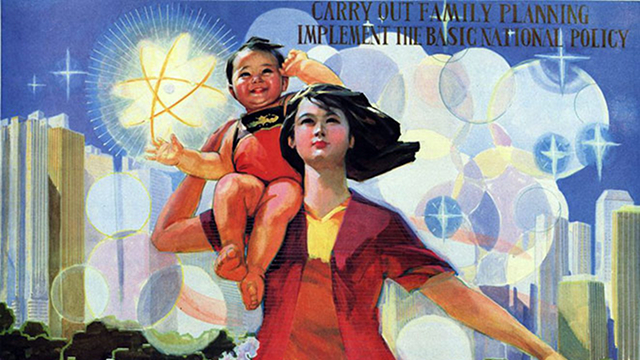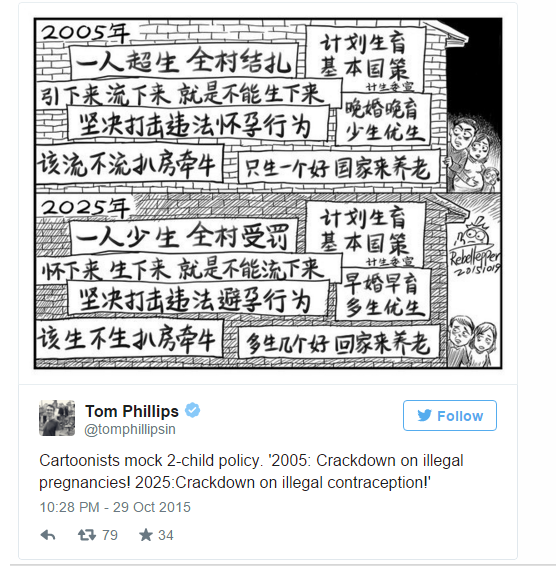
The end of China’s One Child Policy has come; the question now is… so what? Indeed, the end of the controversial policy might be too late… as China’s newly-minted middle class starts to feel the same strains that have kept the birth rate of its other Asian neighbors, such as South Korea an Japan, to a population standstill.
“I want to have a second child but I won’t,” said Wendy Zhang, a 33-year-old pharmacist in Xi’an. “We both have to work, so no one would have time to take care of our children and our life would be too stressful.”
Although a theoretical 100 million couples in China could benefit, of the 50,000 people polled only 20% said that they even wanted or could even afford a second child.
The policy might have worked better had it been implemented much earlier;
“I would want three kids if I had been allowed! But it was in the 1980s — raising kids was much easier then,” said a retiree named Tian Xiling.
“Now my son can’t afford a second child. Food, clothing, education… all cost a fortune today.”
Some intend to wait until the details behind the change are explained in full- the 2-child system will only be formally approved in March next year.
This change does not mean that China will be lifting the floodgates; couples are still only allowed to give birth to 2 children, and will probably still have to apply for birth permits.
“Daughter-in-laws get ready to be nagged by your mother-in-laws,” Weibo user LYMLuWinnie.
“Can Zhang Yimou get the 7.8 million yuan fine refunded?” quipped Weibo user Zhilifangdeyangshitou. He was referring to a famous movie director who had to apologize for having “excessive” children last year.
Durex must have been particularly affected by the announcement; it had this to say on its Weibo account: “The larger the population, the greater the responsibility”. It shouldn’t worry too much.
Repercussions, Or Lack of Thereof – AKA Pointlessly Educational Rambling
Unfortunately, precedence show that China’s move will likely prove to be futile. Singapore is an interesting case, an Asian nation which had also implemented a two-child policy of its own. Two children was a fair target, the replacement rate being about 2.1 children per woman. The policy was aimed at curbing the sudden population boom that occurred just after World War 2 ended in 1942.
Unfortunately, Singapore’s policy was too effective. Highlighting the sheer folly of a government’s arrogant belief that it could manipulate its entire population into submission without consequences, Singapore had to reverse its policy by the 1980s, around the time China applied its own version more-stringent version of Singapore’s policy.
Experimenting with eugenics, of all the despicable things, the Singapore government tried its hardest to target low-income households for its program, even announcing a Graduate’s Mothers’ Scheme in 1984 and offering sterilization for cash to the less educated. Three years after that, it had to reverse course after realizing that birth rates had fallen below replacement levels.
The fact is that as a population becomes more educated, population growth tapers off on its own, as other discerning readers may have noticed with regards to Japan, which has a fertility rate of just 1.4 in 2015 despite NOT having any anti-birth policies, or Taiwan which has a fertility rate of 1.12. (A fertility rate of 1 means that every woman only has one child- a country with a fertility rate of 1, which is reliant solely on births would halve the number of each succeeding generation.)
For a government to stop its less educated (or its entire population) from giving birth is to put the cart before the horse, and worsens a trend that would have occurred anyway. And this was what was observed in Singapore, which has a fertility rate of 0.81 in 2015- the LOWEST fertility rate in the world. China has applied its one-child policy for 35 years, and is only now switching to a two-child policy mimicking Singapore’s, which was run for only about a decade longer.
To believe that anything but complete removal of the policy will have any visible impact is foolish, and this slow reversal only highlights the fact that Chinese policy “Gods” have only just reached their “Singapore” realization… and wish to appear blameless.
China’s current fertility rate is 1.6, close to Singapore’s 1.44 when it had to reverse course. Iran is another country which had pushed population control, only to completely outlaw permanent contraception in 2014 because people trusted and listened to their governments… too well.
It practically won’t have any effect, unless China can address the other causes of low birth rates- the discussion of which is beyond the scope of this piece.
This Article (China Ends Its One Child Policy; What Are The Repercussions?) is free and open source. You have permission to republish this article under a Creative Commons license with attribution to the author(CoNN) and AnonHQ.com.







Hey China!, I love the chinese food, love your martial arts and your traditional music and other things, but please, no more chinese people unless you start educating them!.
My only question is…… Who uses durex? Bwahaahaa